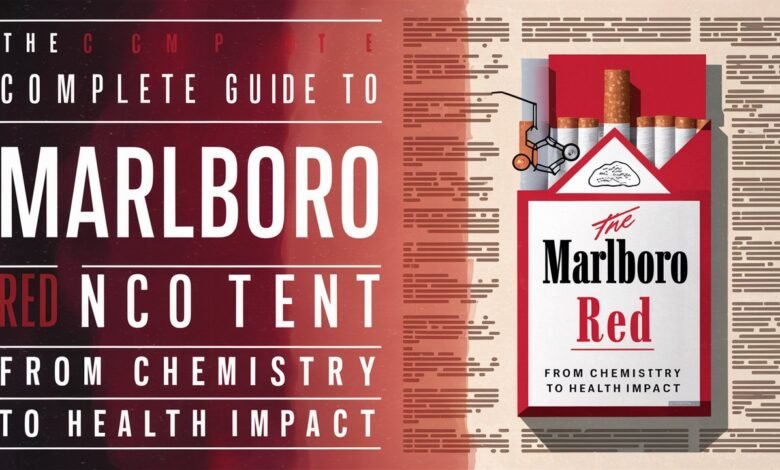The Complete Guide to Marlboro Red Nicotine Content: From Chemistry to Health Impact

Introduction: The Iconic Pack and Its Powerful Contents
Marlboro Reds stand as an enduring symbol in tobacco culture, recognized by their distinctive red-and-white packaging and reputation for “full-flavored” strength. Since their dramatic rebranding from a women’s cigarette to the rugged “Marlboro Man” image in the 1950s, these cigarettes have dominated global markets, with Philip Morris International achieving an estimated brand value of $88 billion by 2017 5. Central to their appeal is nicotine—a potent alkaloid that drives addiction and shapes the smoking experience. This article provides an evidence-based examination of Marlboro Red’s nicotine profile, exploring how its chemical composition, cigarette design, and absorption dynamics contribute to its public health impact. We synthesize data from regulatory filings, independent research, and comparative analyses to illuminate why this particular cigarette variant remains both commercially successful and medically concerning.
Chemical Composition: Quantifying Nicotine and Beyond
Marlboro Reds contain 10.9 milligrams (mg) of nicotine per cigarette—placing them in the upper mid-range among U.S. brands. By comparison:
- Newport: 13.4 mg
- Marlboro Lights: 10.2 mg
- Marlboro Ultra Lights: 6 mg
- Average U.S. cigarette: 11.9–14.5 mg 16
However, nicotine represents just one component of a complex toxicological profile. When burned, Marlboro Reds generate over 7,000 chemicals, including 69 confirmed carcinogens like benzene, formaldehyde, and arsenic 515. Of particular concern are tobacco-specific nitrosamines (TSNAs), carcinogens disproportionately elevated in Marlboro products. A CDC study revealed Marlboro cigarettes contain significantly higher TSNA levels than locally manufactured brands in global markets—a finding attributed to Philip Morris’s cost-cutting manufacturing processes 7. This chemical cocktail interacts synergistically with nicotine, amplifying addiction potential and tissue damage.
Cigarette Design: Engineering Nicotine Delivery
Philip Morris meticulously engineered Marlboro Reds to optimize nicotine delivery through four physical components:
- Filter Design: The 21mm cellulose acetate filter features microscopic ventilation holes. Paradoxically, these “reduce” tar/nicotine yields in machine testing but encourage deeper inhalation by smokers seeking adequate nicotine intake. This behavior deposits toxins deeper into lung tissue 5.
- Combustion Regulators: Cigarette paper contains potassium citrate and tartrate—chemicals that slow burning rates. This allows more puffs per cigarette and prolongs nicotine exposure 5.
- Tobacco Blend: Marlboro Reds use a proprietary mix of Virginia, Burley, and Oriental tobaccos. The high-sugar Virginia tobacco generates higher levels of acetaldehyde when burned—a compound that enhances nicotine’s addictive effects 3.
- Additives: Though marketed as “straightforward,” internal documents list over 600 additives. Ammonia compounds increase nicotine bioavailability by converting it to volatile free-base form, accelerating brain absorption 57.
Table: Nicotine Content Across Marlboro Variants
| Variant | Nicotine Content (mg) | Nicotine Yield (mg) |
| Marlboro Red | 10.9 | 0.8 |
| Marlboro Medium | 10.2 | 0.7 |
| Marlboro Gold | 10.2 | 0.6 |
| Marlboro Silver | 6.0 | 0.5 |
| Marlboro Menthol | 10.2 | 0.7 |
Nicotine Absorption: Content vs. Yield Discrepancy
A critical distinction exists between nicotine content (total nicotine per cigarette) and nicotine yield (amount absorbed by the smoker). For Marlboro Reds:
- Content: 10.9 mg
- Yield: 0.8 mg (ISO machine testing protocol) 1
This gap occurs because machine testing underestimates human smoking behavior. Smokers compensate for nicotine-reducing filters through:
- Blocking ventilation holes with lips/fingers
- Taking larger puffs (≥55ml vs. 35ml in ISO tests)
- Increasing puff frequency 1
Under intense smoking regimens, actual nicotine absorption approaches 1.8 mg/cigarette—translating to 36 mg/pack—far exceeding machine predictions 6.
Comparative Analysis: How Marlboro Reds Measure Up
While often perceived as exceptionally strong, Marlboro Reds rank moderately in nicotine content:
- Pall Mall: 1.3 mg/g (highest among major brands)
- Camel: 1.2 mg/g
- Winston: 1.1 mg/g
- Marlboro Red: 1.0 mg/g 12
Perceived “strength” is influenced by:
- Tar: Marlboro Reds emit 16mg tar—higher than Lights (10mg) but lower than Camel (17mg) 1
- Flavor intensity: Robust, non-menthol flavor enhances throat hit
- Smoking topography: Deeper inhalation increases nicotine bioavailability 12
Notably, “light” variants (e.g., Marlboro Golds) offer no health advantage. Smokers inhale more intensely to achieve desired nicotine doses, negating lower tar yields 1.
Health Implications: Beyond Addiction
Nicotine’s vasoconstrictive effects synergize with Marlboro Red’s toxicants to drive pathology:
- Cardiovascular: Constricts blood vessels, elevating blood pressure and accelerating atherosclerosis. Smokers face 2–4× higher stroke risk 15.
- Reproductive: Reduces uterine blood flow, increasing ectopic pregnancy risk by 30% and preterm delivery by 40% 15.
- Secondhand Smoke: Sidestream smoke (emitted from lit tips) contains higher TSNA concentrations than mainstream smoke. Embryonic stem cell studies show it inhibits cell attachment at 0.1 puff equivalent—indicating profound developmental risks 215.
Table: Health Risks vs. Time After Quitting
| Time Since Quitting | Health Benefit | |
| 20 minutes–12 hours | Heart rate and blood carbon monoxide normalize | |
| 1 year | Heart attack risk drops by 50%; coughing decreases | |
| 5–15 years | Mouth/throat/esophageal cancer risk halves | |
| 15 years | Cardiovascular disease risk matches never-smokers | 15 |
Regulatory Context: The Future of Nicotine Standards
In July 2022, the FDA proposed reducing nicotine in cigarettes to non-addictive levels (<0.5 mg/g) by 2027. This policy aims to:
- Prevent 33 million youth from becoming regular smokers
- Prompt 13 million current smokers to quit 1
However, tobacco companies resist through: - Product differentiation: Marketing “natural” cigarettes (e.g., Natural American Spirit) with higher nicotine (avg. 3.3mg/cigarette under intense smoking) 3
- Litigation: Challenging FDA authority to mandate nicotine reductions 7
Quitting Strategies: Addressing Nicotine Dependence
Nicotine’s addiction cycle involves dopamine and acetylcholine disruption, causing withdrawal symptoms (cravings, irritability, anxiety). Effective cessation combines:
- Nicotine Replacement Therapy (NRT): Combining patches (long-acting) with gum/lozenges (short-acting) increases quit rates by 50% vs. monotherapy 1.
- Behavioral interventions: Counseling addresses cue-induced cravings.
- Pharmacotherapy: Varenicline reduces nicotine reward reinforcement 15.
Conclusion: The Paradox of Precision Engineering
Marlboro Reds exemplify how tobacco engineering optimizes nicotine delivery within a matrix of toxins. Their 10.9 mg nicotine content—coupled with ammonia boosters and inhalation-enhancing filters—creates a highly addictive product that persistently endangers public health. While regulatory efforts to cap nicotine show promise, individual cessation remains paramount. As research confirms, quitting reverses most risks within 5–15 years, underscoring that addiction—unlike cancer—is reversible.
Frequently Asked Questions
- Is Marlboro Red the strongest cigarette?
No. Pall Mall (1.3 mg/g), Camel (1.2 mg/g), and Winston (1.1 mg/g) contain more nicotine per gram than Marlboro Red (1.0 mg/g). Strength perception stems from its higher tar content (16mg) and full-bodied flavor 12. - How much nicotine enters my body from one pack?
While a pack contains 218 mg nicotine (10.9 mg × 20), absorption ranges from 22–36 mg/pack due to incomplete combustion and physiological factors 6. - Are “light” cigarettes safer?
No. Smokers compensate for lower yields by inhaling deeper, taking more puffs, or smoking more cigarettes. Marlboro Lights’ smoke still contains identical carcinogens as Marlboro Reds 17. - Why are Marlboros more carcinogenic than some brands?
Philip Morris’s curing processes and cost-cutting measures elevate TSNA levels. Marlboros contain higher NNN/NNK (lung carcinogens) than many international brands 7. - What’s the most effective way to quit?
Combine long-acting NRT (patches) with short-acting NRT (gum/lozenges) and counseling. This approach manages withdrawal while breaking behavioral cues 115.



